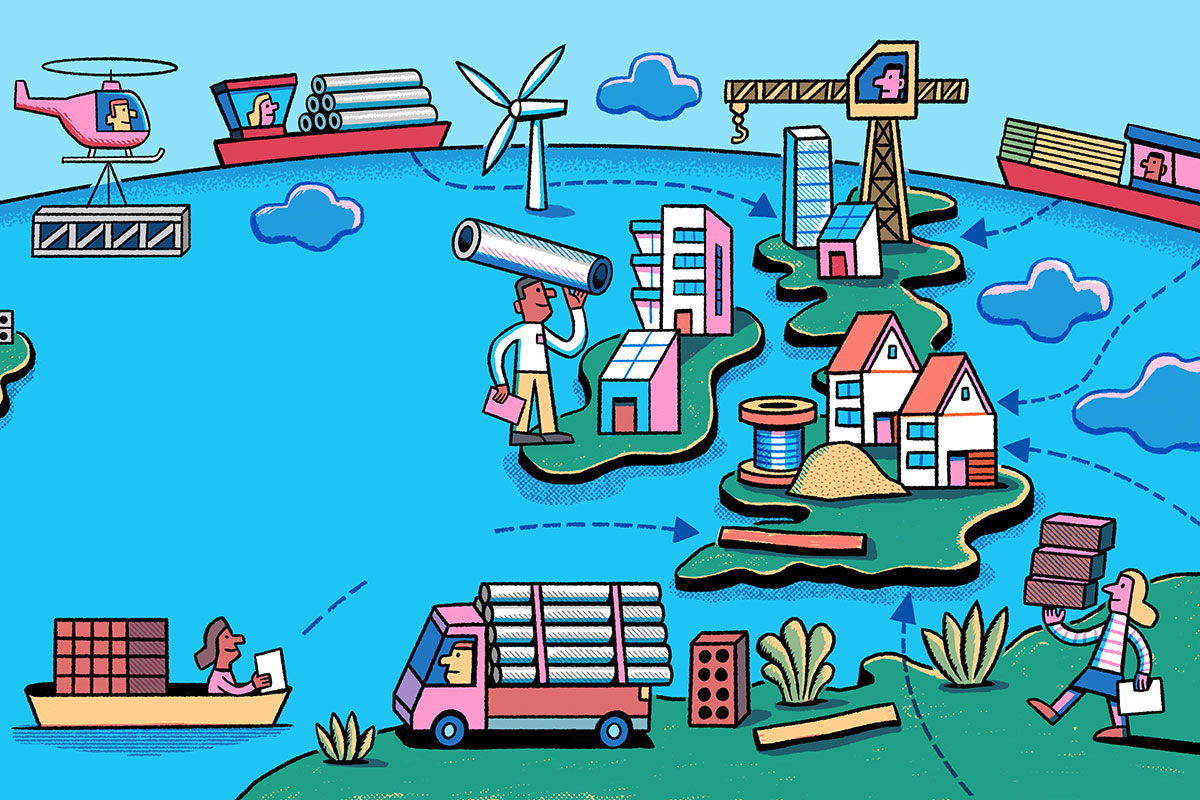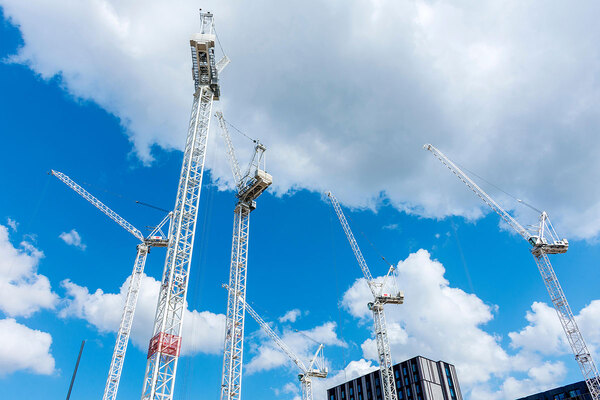CPD module: how to approach decarbonisation policy and strategies
The policy environment on decarbonisation and retrofit is evolving, so how can social landlords continue to build strategies to meet net zero? Richard Ellis, director of sustainability at Peabody, explains in this CPD module, in association with data analytics firm Switchee.
Read the article, take the quiz at the bottom of this article, earn CPD minutes

In association with:

Learning outcomes
After reading this article, learners will be able to:
- Describe national targets for decarbonisation
- Describe the role of Energy Performance Certificates (EPCs). Detail how EPC ratings are determined, and the potential benefits and drawbacks of this method
- Detail the current sources of government funding available to support decarbonisation
- Explain the evolving policy context on decarbonisation
- Describe the progress made to date by the sector, and set this in the context of UK housing more generally
- Understand what organisations must consider when decarbonising their building stock and own operations
- Consider what role digital technology might play in supporting decarbonisation
- Describe how providers can engage residents in decarbonisation work, and explain why it is important
What is the sector being asked to do?
The government’s target of reaching net zero by 2050 covers every sector and region of the UK. This means a 100% reduction of greenhouse gas emissions by 2050 compared to 1990. Any remaining emissions will need to be offset by activities that remove an equivalent amount of greenhouse gases from the atmosphere.
As part of its wider 2050 target, the government has tasked social housing providers in England and Wales with bringing all properties up to Energy Performance Certificate (EPC) Band C by 2035, or 2030 in homes in which fuel poverty is being experienced. As per the government’s English Housing Survey 2019, 39% of social rented homes in England fail to meet this standard.
The Scottish government has set a more ambitious nationwide net zero target of 2045. Its Energy Efficiency Standard for Social Housing (EESSH) sets a non-statutory target to lift all social stock in Scotland to at least EPC Band B – or to be as energy efficient as practically possible – by 2032. In 2022, the Northern Ireland Assembly also set a legally binding target of achieving net zero by 2050, along with interim targets that include a 48% reduction in net emissions by 2030.
Modern heat pumps emit 20% less CO2 than gas boilers, even when powered by carbon-intensive electricity. This reduction can be as high as 80% in countries with a less carbon-intensive grid.
The UK government is preparing to implement a Future Homes Standard, which will require all new build homes in England to be ‘zero-carbon ready’ – that is, fully net zero once the electricity grid is decarbonised – from 2025. Scotland’s New Build Heat Standard mandates that zero direct-emission heating systems – such as heat pumps or heating networks – must be installed in all new homes from 2024.
The Welsh Development Quality Requirements oblige all new social housing in Wales to be built to EPC Band A.
Northern Ireland has yet to set a comparable standard for decarbonising its housing stock. The current requirement is to bring as many homes as possible up to EPC Band C by 2035 where practical.
What activities does the sector need to consider for decarbonisation?
The National Housing Federation estimates that decarbonising all social housing in England would save emissions equivalent to taking 1.8 million cars off the road forever. However, meeting the 2050 net zero target will also require providers to decarbonise their business operations. Everything an organisation buys and uses has a carbon footprint. To start cutting emissions, organisations can begin to look at their procurement, corporate operations and the energy they buy.
Increasing biodiversity (by incorporating more green spaces and wildlife habitats into developments) can also help by offsetting carbon emissions, as trees and plants draw CO2 out of the atmosphere. As of November last year, all developers must by law increase the biodiversity of sites by at least 10%.
What funding has there been to boost the energy efficiency of social housing stock?
How best to fund decarbonisation is a key concern for all social landlords. To date, there have been a few main sources of monies:
- The Social Housing Decarbonisation Fund (SHDF) is the largest source of government funding for landlords in England and Wales. It is worth a total of £3.8bn over a 10-year period. This fund has been disbursed in two waves to date. The first tranche of £179m, which was released as Wave 1 in August 2021, was only made available to local authorities. With Wave 2.1, the scheme was opened up to registered providers. This chunk of funding was worth £778m, which is currently being spent, while Wave 2.2 added a further £80m. In May 2024, the government published a draft of its guidance for Wave 3, which will make £1.2bn available to housing providers starting in April 2025.
- The Home Upgrade Grant (HUG) provides energy efficiency upgrades and low-carbon heating to households in England that are on low incomes, are not connected to a mains gas supply, and have an EPC rating of D or lower. The eligibility for social housing is limited, however – social rented homes can only form up to 10% of an application, and social landlords must contribute at least half of the cost.
- The Energy Company Obligation (ECO) scheme requires energy suppliers to fund and deliver energy efficiency measures to properties. ECO is paid for via levies added to bills. The current scheme, ECO4 – which will run until 2026 – focuses on the least energy-efficient homes and households in fuel poverty. Social homes with an EPC rating of D or lower are eligible.
- In Scotland, the Social Housing Net Zero Heat Fund was launched in 2020. It has made £200m available to 2026 to support providers to install energy efficiency measures and zero direct-emission heating systems (such as heat pumps and district heating networks).
What does a decarbonised home look like?
There are two main elements to consider in decarbonising a home: the way in which the property is heated and how well it keeps that heat in. This means pairing low-carbon heating systems, such as air source heat pumps, with sufficient insulation. The latter reduces energy demand, and therefore emissions, and ensures the home can be heated affordably.
This is easier to achieve in some types of property than others. Social landlords can face a variety of constraints within the building fabric itself, such as hard-to-insulate solid walls, flat roofs unsuitable for loft insulation, or a lack of space for installing heat pumps. External factors can also throw up obstacles – from planning restrictions to constraints on the capacity of the local electrical grid.
How is policy context changing?
In September 2023, the prime minister announced changes to decarbonisation targets for the built environment in England and Wales. These included changes to the government’s plans for decarbonising heating. In 2021, the government began a consultation on its plans to phase out installations of high-carbon fossil fuel heating systems in homes off the gas grid by 2026. In his September speech, Rishi Sunak announced that this change would be pushed back to 2035. An existing ban on the sale of new gas boilers from 2035 remains in place – but it now includes exemptions for homes that are not suitable for heat pumps. These changes will apply to the social rented sector. That said, the government’s commitment to 600,000 heat pump installations per year by 2028 remains in place.
In October 2023, Wales scrapped proposals that required all social housing to reach EPC Band A by 2033; instead, councils and housing associations will set their own decarbonisation plans.
What progress has the sector made towards decarbonisation? What remains to be done?
Social rented housing is, on average, more energy efficient than private rented or owner-occupied housing. Almost two in three social rented homes in England and Wales – 64.3% – are EPC Band C or above, compared with 38.3% of privately rented properties and 35.6% of owner-occupied homes. In Scotland, 65% of social housing is in Band C or above, compared with 50% of private rented homes and 48% of owner-occupied housing, according to Scottish government data.
Inside Housing found that, of 52,000 homes built by the largest players in the sector in 2022-23, only 1,416 could be identified as EPC Band A – more than double the total in the previous year.
The sector is the main user of heat networks, also known as district or communal heating. These systems provide heating to multiple properties from a single source. More than 90% are powered by fossil fuel energy. However, they can be decarbonised relatively easily by converting their heat sources to lower-carbon alternatives such as energy from burning waste, waste heat recovered from industrial processes, or ground or air source heat pumps. The government estimates that 66% of heat network consumers are social tenants, while 20% are owner-occupiers and 11% rent privately.
Despite this progress, the sector is not currently on target to decarbonise by 2050. Events in recent years have diverted resources that providers could have directed towards decarbonisation, such as rent freezes and the urgent and vital focus on building safety.
Most providers, however, do have a zero-carbon plan in place. According to a 2022 survey by the Housing Quality Network, 84% of social landlords have agreed a plan to hit net zero by 2050 or sooner, and 96% say reaching net zero is among their top three priorities.
How can social landlords continue progress towards net zero?
Leaders at Peabody have found that the key to maintaining progress towards decarbonisation lies in accurate and up-to-date data. This includes data on the overall energy efficiency of individual properties, as well as on organisations’ carbon footprints.
When calculating the latter, it can be useful for organisations to consider emissions in three separate ‘scopes’. These were first outlined in the Greenhouse Gas Protocol, a set of standards used by companies around the world:
- Scope 1 covers businesses’ direct emissions – from running boilers or vehicles, for example.
- Scope 2 covers the emissions created in the production of the electricity or in, for instance, the heat a business uses in its offices.
- Scope 3 covers all other indirect emissions, such as those produced along an organisation’s supply chain – those associated with construction materials purchased, for example. For social landlords, Scope 3 also includes the gas and electricity used by residents to heat and light their homes.
To put together a meaningful emissions reduction plan, organisations should take all three scopes into account. This involves obtaining emissions data from suppliers, stakeholders and contractors. It means looking at energy – how it is purchased, and how it is used across the business – to ensure it is being managed as efficiently as possible. That data can then be used to underpin an emissions reduction plan.
Housing providers can play a broader role here, too, by engaging with and educating stakeholders, residents and staff on energy efficiency and cutting emissions, and by encouraging all stakeholders to pull together towards the same net zero goal.
EPCs – what they are, how they are assessed and their benefits and drawbacks
An EPC is a measure of a property’s energy efficiency. It measures two things: the thermal performance of a building, and how much it will cost to heat and light it.
EPC ratings range from ‘A’ for the most energy-efficient buildings to ‘G’ for the least. Assessments are undertaken when a home is built, or when it is sold or rented. This means the ratings might not take recent energy efficiency improvements into account. This is an issue in the social rented sector, where the average tenant has lived in their home for 13 years (compared with four years in the PRS).
EPCs are also only as good as the assessor and the information they provide. The ratings do, however, benefit from being widely understood, and individual inaccuracies tend to even out over large portfolios. Ratings are calculated according to the Standard Assessment Procedure (SAP), the government’s methodology for estimating buildings’ energy efficiency. This is due to be replaced next year by the Home Energy Model, which is intended to improve the accuracy of EPC assessments by simulating energy performance in a more detailed way.
Which data collection approaches are social landlords using?
Digital technology can help to collect, monitor and analyse data, enabling providers to understand their properties at a much more granular level. This in turn should allow more efficient targeting of resources.
Digital stock assessment tools, for example, combine multiple sources of data on each property in a portfolio. These data points can include EPCs as well as up-to-date stock condition information – when was the boiler replaced, or have solar panels been added, for example – to create a detailed and up-to-date profile for each home. Landlords can use this modelling to generate predicted EPC and SAP ratings, and to see what needs to be done to each property to improve its energy efficiency and how much that will cost. This information can feed into long-term financial planning, ensuring resources spent on decarbonisation are used efficiently.
Digital Internet of Things (IoT) technology, meanwhile, can provide constant monitoring of and recording of temperature, air pressure and humidity in homes. This generates real-time streams of data that landlords can use to build a more detailed picture of stock, and to see which properties are the worst-performing and therefore most in need of attention.
How can providers build understanding among residents for decarbonisation?
Retrofit programmes, through which older homes are decarbonised, can be disruptive and messy to residents. They are also time-consuming. Landlords should engage with residents as much as they can up front, and all the way through a retrofit scheme, and should go back afterwards and ask for feedback so that they can learn from any mistakes. Everyone is learning together – contractors, landlords, residents – and it is vital that providers learn those lessons, and bring them to bear on the next project. This will increase the ease with which retrofit programmes can be completed.
Retrofit reduces fuel poverty, makes homes more comfortable and saves residents money. Analysis by the National Housing Federation in 2022 found that bringing all social housing up to EPC Band C would save the average household in England £567 a year. Sharing this knowledge with residents is important to building support for work on decarbonisation.
Areas to reflect on
- Does your organisation have a net zero plan in place?
- What contribution can you make towards helping your organisation decarbonise?
- What further learning might be valuable for you on this topic? How will you pursue that additional learning and knowledge?
- What one point in this piece do you want to share with colleagues who may not have read it? How will you share it?
Summary
The UK government has set a legally binding target of reaching net zero emissions by 2050. The social housing sector has a significant role to play in reaching this goal.
Decarbonising homes involves pairing low-carbon heating systems with sufficient insulation. In addition, social landlords will need to decarbonise their own business operations. Social housing is, on the whole, more energy efficient than other tenures – but the sector is currently not on track to hit its decarbonisation targets. To accelerate progress, housing providers can focus on gathering accurate and detailed data on their housing stock, including by using digital technology. This will enable them to target their resources in the most efficient way.
References and further reading
- National Housing Federation (2021), Defining net zero for social housing
- National Housing Federation (2023), What do the recent net zero policy changes mean for social housing?
- UK government (2023), Government policy on reaching net zero by 2050
- Office for National Statistics (2021), Energy efficiency of housing in England and Wales
- Scottish government (2021), Achieving net zero in social housing: Zero Emissions Social Housing Taskforce report
- UK Government (2024), Social Housing Decarbonisation Fund Wave 3 Scheme Guidance (draft)
- UK government (2024), The Home Energy Model
- IEA (2022), The Future of Heat Pumps
- Housing Quality Network (2022), Landlords and net zero: how tenants are driving change in social housing
Inside Housing CPD content archive
Find out more about Inside Housing’s CPD offering by clicking here
Evaluating the impact of Housing First in the UK
What is the Housing First homelessness model, and how is it applied in this country? Dr Lígia Teixeira, founding chief executive at the Centre for Homelessness Impact, explains more
Fostering data-driven engagement with residents on fuel poverty
Watch the full webinar at the end of this article in association with Switchee, Fostering data-driven engagement with residents on fuel poverty
How have fire safety regulations changed and how can providers remain compliant?
Recent legislation aims to improve fire safety in buildings by increasing accountability and improving fire risk assessments. Andy Frankum, chair of the National Social Housing Fire Strategy Group, explains more
Tenancy fraud – how to spot it and how to fight it
Stephanie Toghill of Islington Council and vice-chair of the Tenancy Fraud Forum explains what tenancy fraud is, how it occurs and how to tackle it
How landlords should deal with TSMs, one year on
Tenant satisfaction measures were brought in by the regulator last year and assess whether landlords are providing quality homes and services to tenants. Tim Quinlan at Riverside explains how it has adjusted to the changes
The importance of good quality data to good air quality
Watch the full webinar, The importance of good quality data to good air quality
Making data-led decisions in social housing
How data is stored and used is crucial for decision-making across the social housing sector. Dr Laura Wales, head of data at Raven Housing Trust, explains why
Building reciprocal relationships with residents
Reciprocity is essential for social landlords to build successful relationships with residents. Anna de Souza and Ingrid Smith at Peabody explain how to go about it
How can social landlords assess whether retrofit is delivering intended performance improvements?
Watch the full webinar, How can social landlords assess whether retrofit is delivering intended performance improvements?
How social landlords should assess and report performance on ESG
Social landlords are increasingly expected not only to consider their environmental and social impact, but also to demonstrate it. Andy Smith, head of impact services at The Good Economy, outlines what providers need to consider
Designing new builds with indoor air quality in mind
Could the drive for energy efficiency in new builds be at the expense of indoor air quality? Dr Jenny Brierley, former housing association chief executive and indoor air quality researcher, explains
AI and robotic process automation – how to use them in social housing
Artificial intelligence and robotic process automation could transform the way social landlords operate and create efficiencies. Monica Quintero, head of digital at Stockport Homes Group, explains the benefits and pitfalls
How to approach decarbonisation policy and strategies
The policy environment on decarbonisation and retrofit is evolving, so how can social landlords continue to build strategies to meet net zero? Richard Ellis, director of sustainability at Peabody, explains
Addressing the development gap in social housing
There is a significant gap between the social housing available in the UK and the number of people who need it. Vicky Savage, executive group director for development and sales at L&Q, looks at the ways in which social landlords can support and increase further development
The importance of indoor air quality
What is indoor air quality, why is it important, and how can it be improved in social housing? Professor Tim Sharpe, head of the department of architecture at the University of Strathclyde, explains
The Procurement Act 2023 – how will it affect landlords?
The Procurement Act 2023 passed into law at the end of last year, with full implementation set for October 2024. How does it change procurement processes, what stays the same and how should social landlords adapt? John Wallace, director of procurement at Clarion, explains all
Funding options in social housing
What does the current finance environment look like in the social housing sector, and what are the different options? Arun Poobalasingam, funding and marketing director at affordable housing aggregator The Housing Finance Corporation, explains more
The new building safety regime
Why has the new building safety regime been introduced, what is different, and what do social landlords need to do to ensure compliance? Andrew Moore, head of operations for building control and planning service at the Building Safety Regulator, explains
The recruitment and retention challenge in repairs and maintenance
The social housing sector faces a challenge in recruiting and retaining repairs and maintenance staff. Mark Coogan, Liz O’Connor, Paul Longman, Russell Thompson and Mike Wilson explore the causes and some potential solutions
Co-production
What is co-production, how can it be fostered, and what are the potential benefits of getting it right? Learn how the concept can be applied successfully to social housing
Psychologically informed environments
How psychologically informed environments take into account how previous trauma might impact people who have experienced homelessness and how they interact with support services
Understanding damp and mould
Housing ombudsman Richard Blakeway discusses how social landlords can tackle the problem of damp and mould in their homes
Tenant satisfaction measures
Watch the full webinar How to collect, report and act on tenant satisfaction measures
Recent content in association with Switchee
CPD webinar on demand: fostering data-driven engagement with residents on fuel poverty
As part of Inside Housing’s CPD offering, watch the full webinar and earn CPD minutes
How can social landlords use data to tackle fuel poverty?
As we enter winter and fuel bills spike, half of social tenants cannot afford to heat their homes, but identifying who those tenants are remains a challenge. Here, sector leaders discuss how better use of data could fight energy poverty
UK fuel poverty: a cool summer affects results
In the fourth Housing Fuel Poverty Index update of 2024, Inside Housing looks at the numbers reported by Switchee’s smart thermostats to help track fuel poverty across the UK
CPD webinar on demand: how can social landlords assess whether retrofit is delivering intended performance improvements?
As part of Inside Housing’s CPD offering, watch the full webinar and earn CPD minutes
What do the latest fuel poverty stats tell us?
In the third Housing Fuel Poverty Index update of 2024, Inside Housing looks at the numbers reported by Switchee’s smart thermostats to help track fuel poverty across the UK
CPD module: how to approach decarbonisation policy and strategies
The policy environment on decarbonisation and retrofit is evolving, so how can social landlords continue to build strategies to meet net zero? Richard Ellis, director of sustainability at Peabody, explains in this CPD module
What will Awaab’s Law mean for landlords and residents?
An Inside Housing roundtable, in association with Switchee, discusses how incoming legislation will affect how landlords approach repairs and maintenance in their homes
Using data to deliver better services
How are landlords collecting data and using it to make decisions about asset management and meeting residents’ needs? An Inside Housing survey, with data analytics firm Switchee, finds out
Is fuel poverty on the decline?
The latest data from smart thermostat provider Switchee suggests that the fuel poverty crisis may be starting to ease. Inside Housing analyses the figures
The numbers behind fuel poverty in the UK
Switchee’s new model shows the number of social households underheating their homes across the UK in real time, during 2022 and 2023. Inside Housing looks into the figures
How can landlords help residents to save on energy bills?
Inside Housing speaks to Emma Bitting at Switchee to find out what residents can do to ensure their homes are warm, and how they can save money on bills
How landlords are using data to tackle fuel poverty
An Inside Housing roundtable, in association with Switchee, discusses how landlords can analyse data to ensure they are helping residents who are struggling with energy costs
Internet of Things devices start to make a difference
A national network of vetted installers means the industry can collaborate to provide landlords with invaluable insights, says Philip Taylor of Internet of Things device provider Switchee
Choosing smart data and tech can help landlords achieve Better Social Housing Review goals
Technology can help landlords in terms of their business and regulatory compliance, as well as improving residents’ quality of life and bringing down bills, explains Tom Robins of tech firm Switchee










